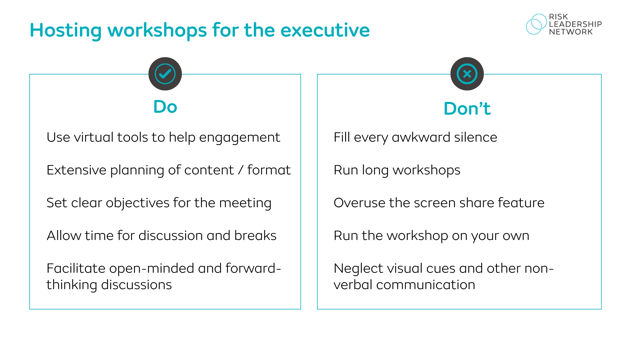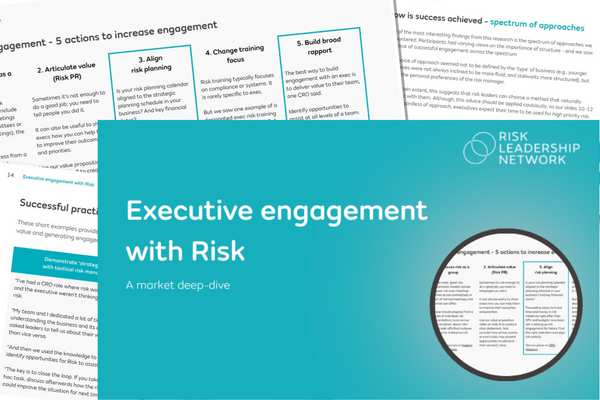Five ways to boost executive engagement with risk
On paper, building engagement with executives would appear straightforward. Unlike some of the more technical areas of risk, engagement doesn't require much prior expertise to understand. Yet, when a member raised executive engagement as a key priority, we discovered that the challenge was shared by many of our member organisations.

1. Discuss risks regularly with executives as a group
While most "good" risk governance models are likely to include regular touch points between one or more representatives of the enterprise risk team and the executive committee, the format can differ.
|
Examples:
|
The format may differ, but what matters is that there is a consistent cadence of interactions between Risk and the executive layer of the business.
These interactions should progress beyond a series of individual presentations by the risk team, which can create a one-sided conversation in isolation. Instead, encourage an active discussion about risks and trade-offs that nurture a dynamic 'enterprise risk view'.
You may even want to host semi-regular workshops with your executive committee to go into more detail on the business' set of material risks:

2. Articulate the value of risk management
In many cases, the risk team has to be its own PR agency, highlighting the value it has brought to the business, in order to encourage executive buy-in and support.
If you are trying to communicate to executives how Risk can support the organisation, always be outcome-focused and frame your role in terms of how you can help solve their priorities.
The best value is when Risk challenge our exec team to look at a major issue from a different perspective. However, it must come from a position of commercial understanding. Risk must also know the business."
.png?width=1080&height=1080&name=Untitled%20design%20(2).png)
CRO, ASX 100 organisation
Risk Leadership Network member
When you do get that coveted face-time with the executive committee, you may want to have a value proposition ready to make a clear statement about the purpose of risk management. The key question to answer is "why is it important to invest time and resources in the risk function of the business?".
You might want to include the following in that value proposition:
|
What Risk (should) do:
|
Is your risk management calendar aligned to the strategic planning schedule of your business. What about key financial dates?
Persuading executives to invest time and money in risk initiatives after KPIs and budgets have already been set? You're setting up attempts at greater risk engagement for failure. Clearly then, aligning calendars and making sure Risk can provide a perspective before budgeting and planning decisions have been made is pivotal.
Where did this insight come from?A Risk Leadership Network member raised the challenge of executive engagement as their key priority. As part of our bespoke solution we: 1. Created a benchmark on executive engagementThis enabled the member to get ideas of ways that other CROs and heads of risk are engaging their executives (c-suite, board). 2. Facilitated a series of 1-to-1 meetings Watch the full case study here This article shares some of the high-level takeaways from these collaborations. Of course, more details and practical insights were shared with our members involved. Find out more about membership to see how we could facilitate peer-led collaborations to help with your biggest challenge. |
4. Recalibrate the focus of risk training
Across the companies we've spoken to, risk management training typically focuses on systems or compliance. It's rarely specific to executives and what risk management can do for them.
In reality, executives are less likely to be interested in operational procedures and the nuts and bolts of risk management; instead, use risk training to explain how the executive fits into the overall risk management structure and keep the big picture at the forefront of conversations.
A real-life example from a CROOne company has offered a particularly strong example of how they achieved greater levels of risk engagement from executives through training:
|

5. Build broad rapport across business
The best way to build engagement with an executive is to deliver value to the rest of their team."
.png?width=1080&height=1080&name=Untitled%20design%20(2).png)
CRO, FTSE 100 organisation
Risk Leadership Network member
While addressing the priority issues of individual executives can help drive greater one-to-one engagement with them, try to identify opportunities to assist at all levels of their team. In particular, focus on helping them with risks that are aligned to strategic priorities.
Ultimately, goodwill and reputation will filter up. The executive leading this team is more likely to engage, as the risk team won't be the only part of the business to communicate its value.
What's next?
None of the risk leaders we have spoken to take engagement for granted. All agree that it requires a deliberate effort on behalf of the enterprise risk team, often requiring communication with not only executives, but a wider group of stakeholders across the organisation.
We'll continue to support risk leaders on executive engagement — and any other risk priorities they raise with us. To learn more about what we've got coming up, book an introductory call or find out more about membership on our website.
Share this
Related posts you may be interested in

A 10-point risk training guide for boards and executives

Three ways your peers are developing their risk function in light of emerging risks

